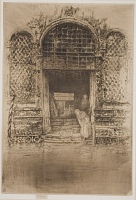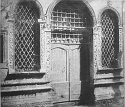Etchings Institutions search term: grolier club
The Doorway | ||
| Number: | 193 | |
| Date: | 1879/1880 | |
| Medium: | etching, drypoint and roulette | |
| Size: | 295 x 204 mm | |
| Signed: | butterfly at upper left | |
| Inscribed: | no | |
| Set/Publication: | 'First Venice Set', 1880 | |
| No. of States: | 20 | |
| Known impressions: | 66 | |
| Catalogues: | K.188; M.185; W.154 | |
| Impressions taken from this plate (66) | ||
KEYWORD
TITLE
'The Doorway' (1880, F.A.S.). 1
'Venezianisches Palastthor' (1881, Berlin). 2
'La grande porte – Venise' (1892, Paris). 3
'The Doorway' (1886, Frederick Wedmore (1844-1921)). 4
'Doorway (Venice)' (1889, Exposition Universelle). 5
'The Doorway; - Venice' (1903/1935, possibly Rosalind Birnie Philip (1873-1958)). 6
'Le portail. - (The Doorway)' (1905, Paris). 7
The original title 'The Doorway' is accepted by the majority of later publications including oeuvre and exhibition catalogues.
1: Venice, a Series of Twelve Etchings.
2: Berlin 1881 (cat. no. 708).
3: Paris Soc. Nat. 1892 (cat. no. 1670).
4: Wedmore 1886 A (cat. no. 154).
5: Paris Exp. Univ. 1889 (cat. no. 419)
6: Envelope containing copper plate, Hunterian Art Gallery.
7: Paris Mem. 1905 (cat. no. 356).
DESCRIPTION
SITTERS
SITE
8: Bacher 1909 , p. 195, 'The Renaissance Door.'
9: Grieve 2000 , p. 92.
DISCUSSION


